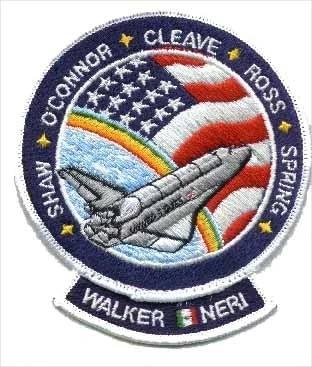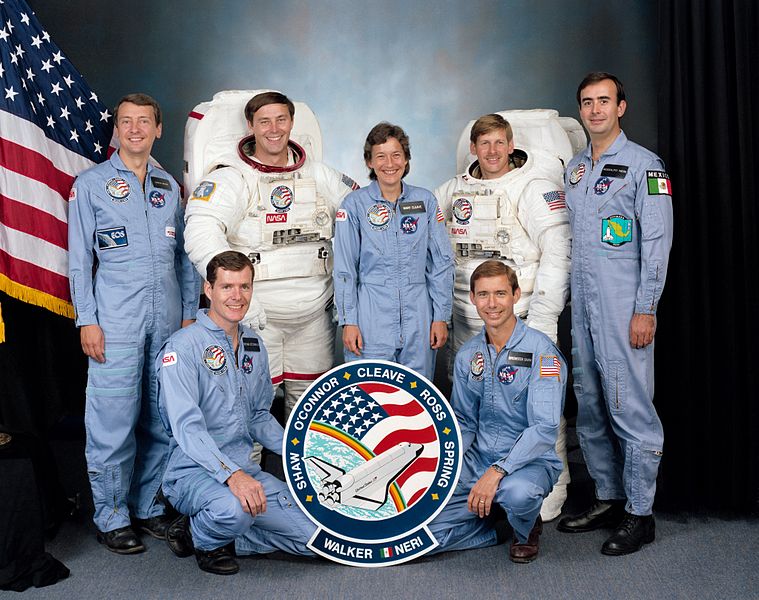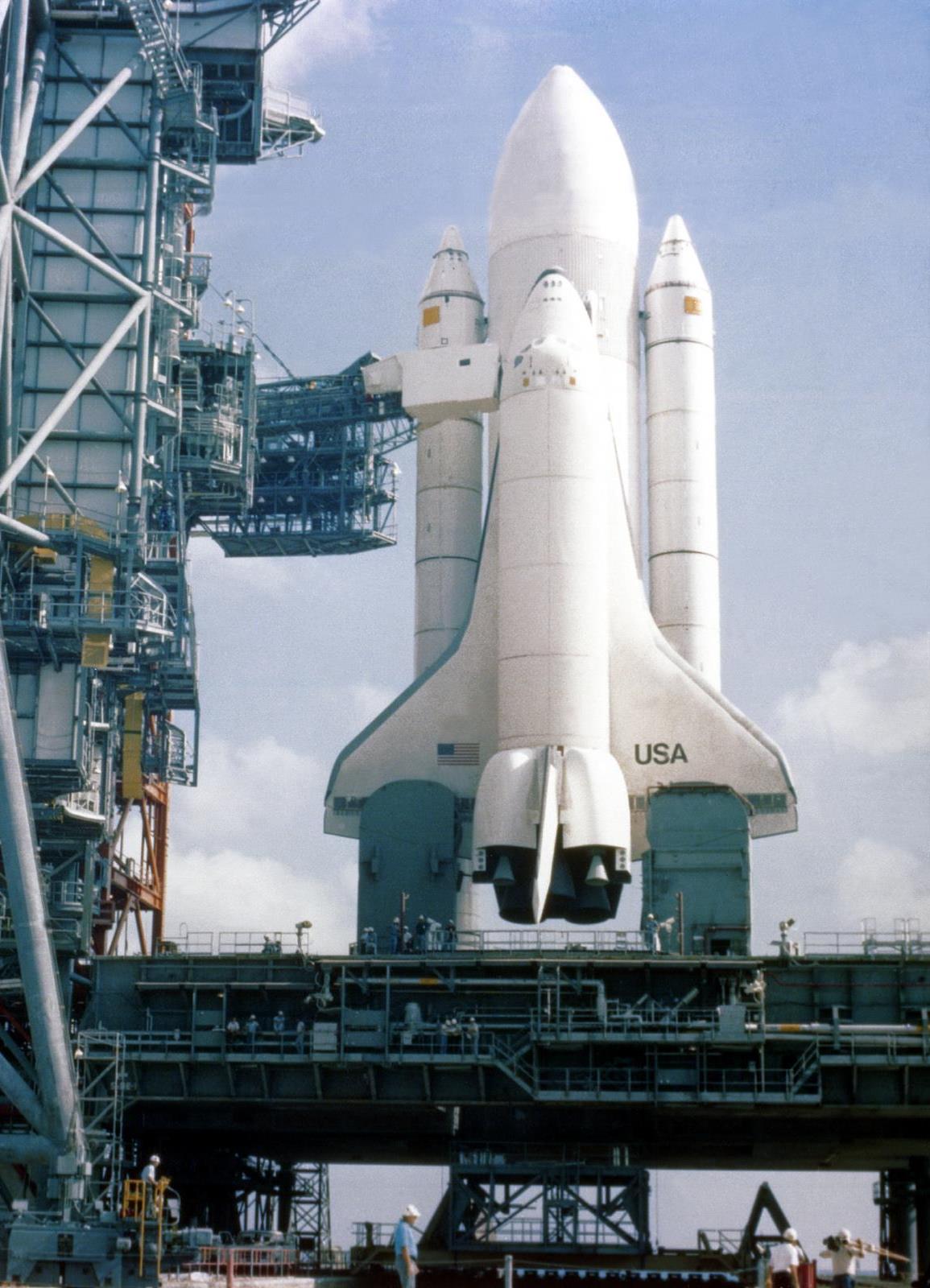Brewster H. Shaw Jr.
(Second Space Flight)
Bryan D. O'Connor
(First Space Flight) Mission Specialist 1:
Sherwood C. Spring
(First Space Flight) Mission Specialist 2:
Mary L. Cleave
(First Space Flight) Mission Specialist 3:
Jerry L. Ross
(First Space Flight) Payload Specialist 1:
Rodolfo Neri Vela
(Mexico - First Space Flight) Payload Specialist 2:
Charles D. Walker
(First Space Flight)
STS-61-B was NASA's 23rd Space Shuttle mission, and its second using Space Shuttle Atlantis The shuttle was launched from Kennedy Space Centre, Florida, on 26 November 1985. During STS-61-B, the shuttle crew deployed three communications satellites, and tested techniques of constructing structures in orbit. Atlantis landed at Edwards Air Force Base, California, at 16:33 EST on 3 December 1985, after 6 days and 21 hours in orbit.
STS-61B was the quickest turnaround of a shuttle orbiter from launch in history - just 54 days between Atlantis's launch on STS-51J and launch on STS-61B. The mission also carried the first Mexican astronaut. Rodolfo Neri Vela.
A free template by Lucknowwebs.com for WYSIWYG WebBuilder 8
Study
Research
Main Index
Space Cosmology
Science Research
*
About
Science Research
Science Theories
Desk
Site Map
BookShelf
Copyright © by Nigel G Wilcox · All Rights reserved · E-Mail: ngwilcox100@gmail.com
Designed by Nigel G Wilcox
Powered By AM3L1A
Pages within this section: USA Shuttle Mission Flights
STS-61b
Pages within this section:
The Space Shuttle Missions
Astronauts:
STS-61b
Command Pilot:
Pilot:
60
M
8
SM
Sub-Menu
menu
-
61
61a
61b
61c
61e
61h
61m



A key element of the mission's objectives was EASE/ACCESS, an experiment in assembling large structures in space. EASE/ACCESS was a joint venture between the Langley Research Center and the Marshall Space Flight Center. ACCESS was a "high-rise" tower composed of many small struts and nodes. EASE was a geometric structure shaped like an inverted pyramid, composed of a few large beams and nodes. Together, they demonstrated the feasibility of assembling large pre-formed structures in space. Astronauts Jerry Ross and Sherwood Spring performed the two spacewalks of the mission which marked the 50th and 51st U.S. (12th and the 13th for the Shuttle) EVAs. An IMAX camera mounted in the cargo bay filmed the activities of the astronauts engaged in the EASE/ACCESS work, as well as other scenes of interest.
"This is probably not the preferred way of building a space station," Ross said later of EASE. The astronauts reported that the most difficult part of the spacewalks was torquing their own masses while holding the EASE beams. The ACCESS worked well, while EASE required too much free floating. The astronauts judged that performing six-hour spacewalks every other day over a five or six-day period was feasible, and recommended glove changes to reduce hand fatigue. Ross said in the Extra-Vehicular Activity (EVA) debrief that the crew had tried to have the Manned Maneuvering Unit (MMU) manifested for use in the second spacewalk, because "for certain applications it would be very useful. In particular if you were building portions of a space station attached to the orbiter, then moving those portions farther than the manipulator arm could transport them." He added that the MMU could be used to attach cable runs and instruments in places out of reach of the shuttle's robotic arm (RMS).
During the mission, astronaut Rodolfo Neri Vela accomplished a series of experiments, primarily related to human physiology. He also photographed Mexico and Mexico City as part of the mission's Earth observations. Astronaut Charles Walker again operated the Continuous Flow Electrophoresis System, the third flight of this larger and improved equipment, to produce commercial pharmaceutical products in microgravity. An experiment in Diffusive Mixing of Organic Solutions, or DMOS, was conducted successfully for 3M. The object of this experiment was to grow single crystals that were larger and more pure than any that could be grown on Earth. One Getaway Special canister stored in Atlantis' payload bay carried a Canadian student experiment, which involved the fabrication of mirrors in microgravity with higher performance than ones made on Earth.
All the experiments on this mission were successfully accomplished, and all equipment operated within established parameters. Atlantis landed safely at Edwards Air Force Base at 16:33 EST on 3 December 1985, after a mission lasting 6 days, 21 hours, and 5 minutes. Atlantis landed one orbit earlier than planned due to lighting concerns at the Edwards AFB. Rollout distance on landing was 10,759 feet lasting 78 seconds.
Space Shuttle Atlantis lifted off from Pad A of Launch Complex 39 at Kennedy Space Center at 19:29 pm EST on 26 November 1985. The launch marked the second night launch of the Space Shuttle program, and the ninth and final flight of 1985.














